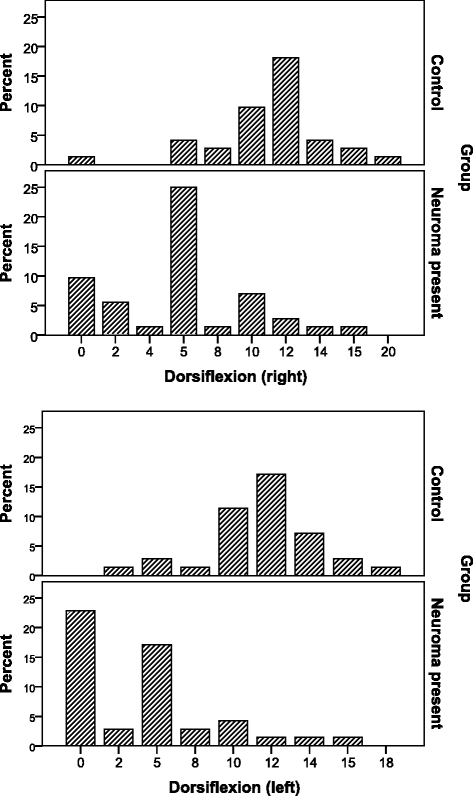The relationship between foot posture index, ankle equinus, body mass index and intermetatarsal neuroma
- PMID: 27980684
- PMCID: PMC5131555
- DOI: 10.1186/s13047-016-0179-9
The relationship between foot posture index, ankle equinus, body mass index and intermetatarsal neuroma
Abstract
Background: The main purpose of this study was to investigate the presence of an association between intermetatarsal neuroma and foot type, as measured by the Foot Posture Index. The study also examined whether there was a relationship between foot type and the interspace affected with intermetatarsal neuroma, and whether ankle equinus or body mass index had an effect.
Methods: In total, 100 participants were recruited from The University of Western Australia's Podiatry Clinic, 68 of whom were diagnosed with inter-metatarsal neuroma from 2009 to 2015. There were 32 control participants recruited from 2014 to 2015. The age of subjects was recorded, as were weight and height, which were used to calculate body mass index. The foot posture index and ankle dorsiflexion were measured using standard technique. Independent t-tests and Kruskal-Wallis tests were used to compare differences in foot posture index, body mass index and ankle dorsiflexion between the inter-metatarsal neuroma and control groups. Multivariable logistic regression was also used to model relationships for outcome.
Results: The 68 intermetatarsal neuroma subjects had a mean age of 52 years (range 20 to 74 years) and comprised of 56 females and 12 males. The 32 control subjects had a mean age of 49 years (range 24 to 67 years) with 26 females and six males. There were no significant differences between the control and the intermetatarsal neuroma groups with respect to the mean foot posture index scores of the left and right foot (p = 0.21 and 0.87, respectively). Additionally no significant differences were detected between the affected intermetatarsal neuroma interspace and foot posture index (p = 0.27 and 0.47, respectively). There was no significant difference in mean body mass index between the intermetatarsal neuroma (26.9 ± 5.7) and control groups (26.5 ± 4.1) (p = 0.72). There was, however, a significant difference in mean ankle dorsiflexion between the intermetatarsal neuroma and control groups (p < 0.001 for both feet). Logistic regression models, adjusted for age, sex, foot posture index and body mass index estimated that the odds of having an intermetatarsal neuroma in the right foot increased by 61% (OR 1.61; 95% CI 1.32-1.96) with each one degree reduction of ankle dorsiflexion, and in the left foot by 43% (OR 1.43; 95% CI 1.22-1.69).
Conclusion: No relationships were found between foot posture index and body mass index with intermetatarsal neuroma, or between foot posture index and the interspaces affected. However, a strong association was demonstrated between the presence of intermetatarsal neuroma and a restriction of ankle dorsiflexion.
Keywords: Body mass index; Equinus deformity; Neuroma.
Figures
References
MeSH terms
LinkOut - more resources
Full Text Sources
Other Literature Sources
Medical



